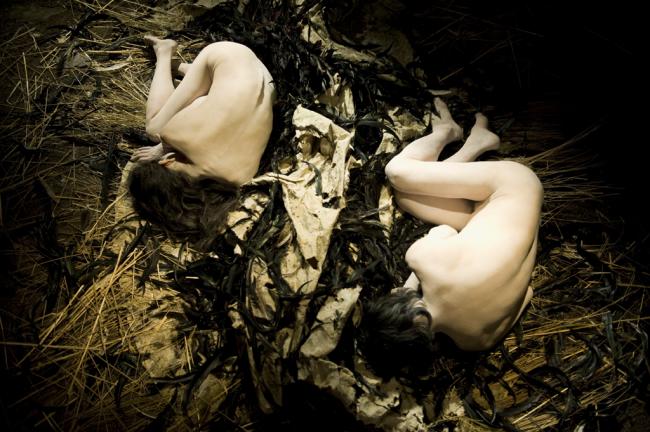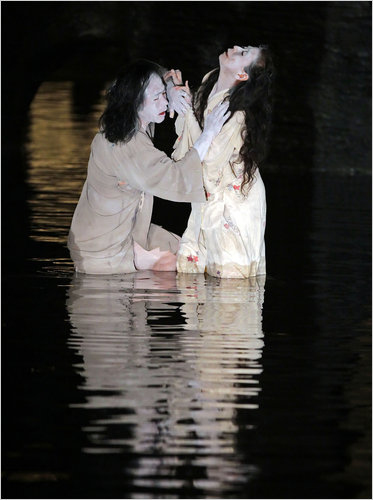What will happen next? Their performances can be termed movement of a contrapuntal nature. While moving with extreme and varying degrees of slowness, they are also masters of suspense. The dance productions of Eiko and Komo have been termed a poetry of stillness in a moment stretched to infinity. The art has been to retain dramatic tension within a context of glacial slowness in which two bodies move toward and away from each other in infinitely small increments: mini dramas of time and space. From a review of their show “Naked”: …

---"The clearest difference is there is no beginning, no middle and no end, because we don't control how people come in," Eiko said. However, as Koma points out, when people do come in they are inside an artwork and very close to them as performers. "It's almost about 4 feet away from where the audience is sitting, so the audience might feel that if they wanted they could almost touch us, a touchable distance," he said. ---Read More:http://minnesota.publicradio.org/display/web/2010/11/02/naked-walker/
…At first glance it’s shocking how inhuman the bodies appear. As they lie on their sides, an arm wrapped under a waist, a leg angled, part of the body covered by feathers and sticks, their limbs look inanimate, part of the natural detritus around them. Their dark hair flows into the dark feathers; their bodies are smeared with dirt. They seem without sex or individuality, and then, as the lights brighten and dim, we begin to make out their faces and to piece together the contours of their frames.
No sooner is their humanity apparent than other images and ideas emerge: Eiko’s bone-thin, fragile body, never still, yet barely moving, inexorably evokes death, battlefields, natural disasters , skeletons slowly decaying into the earth. Komo’s hand, stretching toward her, looks almost grotesquely white and large, a horror-film image of death itself….

---Eiko and Koma have remarked, “We often take our inspiration from nature, which has its own sense of time and a grotesqueness that in our eyes can be beautiful.” I can’t think of a more perfect way to describe the visual assault that is an Eiko and Koma performance—complex, hyperbolic and deeply oxymoronic. Their true genius is an uncanny ability to simultaneously offend and captivate, perplex and create common ground, manipulating time and space to blur the lines between.---Read More:http://berkshirereview.net/dance/eiko_koma_hunger.html
…But these are just part of the almost infinite narrative of the work. To watch the pair is to marvel at the immense control with which each is almost always moving yet can appear entirely still. Over the four hours they do little more than reach toward each other, occasionally touching and moving away, the mound of leavings gradually molded into a small barrier between them. Yet those small shifts of position provide an intense suspense and drama, as does the occasional sight of a whole face, turned up to the light. Nothing happens exactly, and everything does. They are both human and animal, personal and archetype, alive and dead. In the first half they face away from each other; in the second they curl inward, in fetal position, toward each other. Each of those positions suggests something new, subtly alters the drama. Read More:http://www.nytimes.com/2011/03/31/arts/dance/eiko-and-koma-in-naked-at-baryshnikov-center-review.html
Its a dance form based on minimalism of different stripes that evokes the performance style and the narrative often embodies the theme of human vulnerability and inevitable decay and rebirth. The dances themselves have no plot, no cadenced linear progression that conforms to Western chronological convention. Everything is basically a continuous groping forward with an inscrutable sense of purpose underlined by a tenacious instinct to survive. Both performers were the first generation after after Hiroshima and the former student radicals oeuvre is inflected with a certain traumatism and courageous defiance.

---Andrea Mohin/The New York Times Eiko & Koma The duo performing “Water,” in the Paul Milstein Pool at Hearst Plaza, part of the Lincoln Center Out of Doors festival. ---Read More:http://www.nytimes.com/2011/08/01/arts/dance/eiko-koma-at-lincoln-center-out-of-doors-review.html?_r=1
…Koma looks like us. Things happen to him. Eiko is what happens. She is our ghost, our bad dream, our coming death. Finally, there is the subtlety, the knottedness, the ambiguity of their gestures. I must say that their shows, like Noh plays, are too long and too slow for me. I start thinking: Did I feed the cat? Did I send my aunt a birthday card? That experience is not so strong with “Naked,” because this piece is open-ended. You can come and go as you please. (Each night, Eiko and Koma perform for four to six hours, with one five-minute break.) But, however much you may zoom in and out, you are rewarded, when you zoom in, by the intensity of the proceedings.Read More:http://www.newyorker.com/arts/critics/dancing/2011/04/11/110411crda_dancing_acocella
Eiko and Komo seem to force upon us the artificiality of the reality of time.That is, our perception of time relies upon awareness of the movement around us.If that movement is disjunctive or disrupted a dislocation happens; an alternate reality in which temporal and habitual references are put into question. If their particular journey has passed through a time crack what about ours as witness to this? In its stread, a passage through space starts to resemble an ancient and eternal cyclical struggle of countless generations of living things,perhaps even extending to the origins of the planet itself and that vague and ambiguous space between creation and myth as seen by time channelers and travelers.
Eiko and Koma allow us to attain a form of global consciousness through a liberation of our own, restraining and confining narrow rhythms that control our lives, or that we let enter into our space. By standing outside this structure, we can smell the fresh breeze of connectedness; liberty?
see how limited and antiseptic our own existence can appear from an objective distance.ADDENDUM:
From the New Yorker: Eiko and Koma Otake, both born in Japan soon after the Second World War—she is fifty-nine, he is sixty-two—never had any intention of becoming theatre artists. In the nineteen-sixties, at their respective universities, they both studied political science. But in Japan, at that time, as in the United States and Europe, there was a widespread student-protest movement, mainly antiwar, mainly in response to the huge postwar military presence of the United States in Japan, a situation that de facto involved the Japanese in the Vietnam War. The students’ conflict with the authorities was nasty: tear gas, clubbings, jailings. Eiko and Koma were part of it. (Koma bound one of his professors with tape and threw him out of the classroom.) The two of them, independently, left university and turned to avant-garde dance, a form popular with Japanese radicals, since it seemed to them free from capitalism, commodification, conservatism, and conformity. They briefly worked in the studios of Tatsumi Hijikata and Kazuo Ohno, pioneers of the rather horrifying, anti-traditional style called Butoh. (It was in Hijikata’s studio, in 1971, that they met.) They got little attention from these masters, however, and so they moved to Germany, where there was still a remnant of the highly expressionist modern-dance movement that had been led by Mary Wigman before the Second World War. By now, Eiko and Koma were not just dancers but choreographers. In Hanover, they studied with Manja Chmiel, who had been Wigman’s assistant, and she taught them economy—how to find what they really wanted to say and then scrub away the rest. Eventually, the couple decided to go to New York, at that time the capital of experimental dance.
Read more http://www.newyorker.com/arts/critics/dancing/2011/04/11/110411crda_dancing_acocella#ixzz1TyE7eHXM





 COMMENTS
COMMENTS